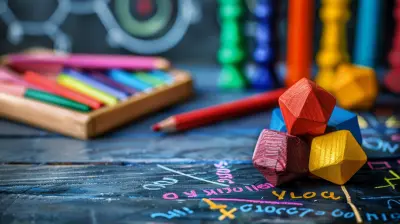How to Organize Your Notes for Maximum Retention
1 October 2025
Let’s face it—note-taking can sometimes feel like a chore. You scribble things down during class or while studying, but when you look back a few days later, it’s a mess. The info is there... somewhere, but it’s buried under chicken-scratch handwriting or scattered across five different apps and notebooks.
Sound familiar? You’re not alone.
The truth is, how you organize your notes can be the game-changer between understanding a topic deeply or forgetting it two days later. Want to retain more from your classes, study sessions, or online courses? Then you’ve got to level up your note-taking game.
In this post, we’re going deep into how you can organize your notes for maximum retention. No complicated systems—just smart, effective strategies that actually work.
Why Organizing Your Notes Matters
Before jumping into the “how,” let’s talk about the “why.” Why even bother organizing notes?Imagine trying to find a single sock in a messy room. You might get lucky... or you might waste 20 minutes digging through the clutter. That’s your brain on disorganized notes.
When notes are well-structured and clear:
- You save time during review.
- Your brain connects information more easily.
- You turn passive writing into active learning.
In other words, organized notes = better memory, less study time, and more clarity. Sounds like a win, right?
Understand Your Learning Style First
Here’s the thing: Not everyone learns the same way.Before settling on a note-taking method, ask yourself: _How do I learn best?_
- Visual learners thrive on diagrams, charts, and color-coded notes.
- Auditory learners remember what they hear—think voice memos or class recordings.
- Reading/writing learners love written words—hello, traditional note-taking!
- Kinesthetic learners need to engage with the material—think flashcards or rewriting notes.
Knowing your style helps you tailor your notes to how your brain works best.
Choose the Right Note-Taking Method
Let’s break down a few popular note-taking methods—and how each can help with retention.1. The Cornell Method – A Classic for a Reason
Split your page into three sections: Notes, Cues, and Summary.- Notes: Main ideas during class.
- Cues: After class, jot down questions or keywords.
- Summary: Write a short recap at the bottom.
Why it works: It forces you to interact with the material after the lecture, which is key for retention. It’s like reviewing a movie right after watching it—helps solidify the plot.
2. The Outline Method – Great for Structured Thinkers
Use indents to organize information hierarchically.
I. Main Topic
A. Sub-topic
1. Detail
2. Example
Why it works: Neat, clean, and logical. Perfect for subjects with clear structures like history, biology, or economics.
3. The Mapping Method – A Visual Brain's Best Friend
Think of this like a mind map. Start with the central concept in the center, and branch out ideas around it.Why it works: Helps you visualize relationships between concepts. Super useful for systems, processes, or brainstorming.
4. The Charting Method – For Data-Heavy Topics
Create columns and rows to compare and contrast info.Why it works: Perfect for subjects like medicine, law, or stats where comparisons are key. Seeing things side-by-side beats reading blocks of text.
5. The Flow Method – For Creative Thinkers
Instead of using a rigid format, jot things down freely—like a journal. Use arrows, doodles, abbreviations, highlights—whatever helps you understand.Why it works: It mirrors how your brain makes connections in real time. Great for creative thinkers or complex subjects.
Go Digital or Stay Analog?
This debate pops up often. Should you take notes by hand or use a digital device?Handwriting Pros:
- Helps with memory retention (science backs this up).- Fewer distractions—no apps or messages popping up.
- Engages more parts of your brain.
Digital Pros:
- Easy to organize and search.- Syncs across devices.
- Great for multimedia notes (links, images, recordings).
Here’s the trick: Combine both! Handwrite your initial notes, then type them up later. This second pass helps reinforce the material. Double win.
Make Reviewing Notes a Ritual
Organization isn’t just about layout—it’s also about how often you revisit your notes.Let me introduce you to the Spaced Repetition technique.
Instead of cramming, review your notes at spaced intervals:
- Day 1: Take notes.
- Day 2: Review and revise.
- Day 4: Quiz yourself.
- Day 7: Teach the material to someone else (or pretend to).
This builds stronger memory pathways. It’s like watering a plant regularly, not flooding it all at once.
Color-Coding: Not Just for Fancy Bullet Journals
Color helps your brain categorize and prioritize.Here’s a simple color system:
- 🔵 Blue = Definitions
- 🟢 Green = Examples
- 🔴 Red = Important!
- 🟡 Yellow = Questions / Unclear Info
You can highlight, underline, or just write in colored pens. It’s not about making it pretty—it’s about making it stick.
Use Visual Tools Like Diagrams and Charts
A picture really is worth a thousand words—especially when you’re trying to understand complex ideas. Don't just write explanations. Draw them!- Flowcharts for processes
- Venn diagrams for comparisons
- Timelines for historical events
- Concept maps for relationships
You don’t need to be an artist. Sketch stick figures if you have to—just make it visual.
Keep One Master Notebook or Hub
It’s tempting to use different notebooks or apps for each class, topic, or week. But trust me—it becomes chaos fast.Instead:
- Use one big notebook with dividers, or
- Create a digital “hub” using tools like Notion, Evernote, or OneNote.
Make it your central brain. Everything goes here: notes, ideas, class materials, reminders. It simplifies your workflow and makes finding stuff easy.
Regularly Clean and Summarize
Just like your room, your notes need tidying up.Every week, take 20–30 minutes to:
- Organize loose papers or files.
- Summarize the main ideas from the week.
- Reflect: What clicked? What’s still fuzzy?
These mini check-ins help you stay on track and avoid that Finals Week panic spiral.
Practice Active Recall, Not Passive Review
Reading your notes over and over? Useless after a point.Instead, try:
- Covering them and reciting info out loud.
- Teaching the content to a friend (or your cat—no judgment).
- Writing questions in the margins and testing yourself later.
Your brain remembers what it works to recall. So make it work!
Bonus Tips to Stay Organized
- 📌 Use sticky notes for quick reminders or questions.- 📱 Take photos of whiteboards or diagrams during class.
- 📁 Use folders (literal or digital) for each subject or project.
- 🗓 Set reminders to review your notes weekly.
Small habits, big results.
Final Thoughts
Organizing your notes doesn’t have to be fancy. It just has to work for you. The goal isn't to create Instagram-worthy pages—it’s to make studying easier, faster, and more effective.So play around. Mix and match methods. Test what sticks. You’ll be amazed how a few tweaks can seriously boost your memory and understanding.
Remember: studying smarter beats studying harder. Always.
all images in this post were generated using AI tools
Category:
Study TipsAuthor:

Olivia Chapman
Discussion
rate this article
1 comments
Kieran McCool
Organizing your notes for maximum retention? Think of it like Tetris—fit those pieces together until they click! Just remember, unlike in Tetris, there’s no ‘game over’ when you misplace a sticky note! Keep it fun, keep it colorful, and your brain will thank you later!
October 13, 2025 at 3:11 AM

Olivia Chapman
Great analogy! Organizing notes creatively not only enhances retention but also makes the process enjoyable. Keep stacking those pieces!


